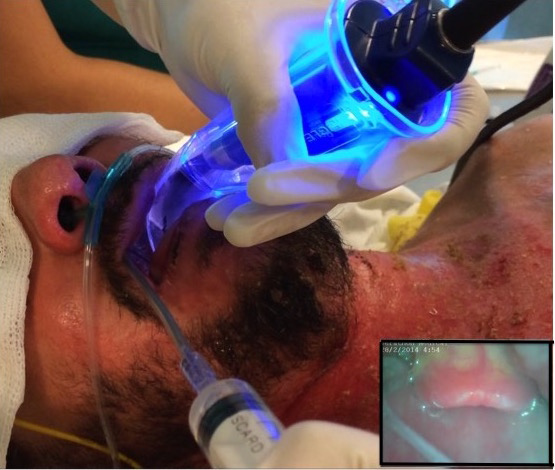Journal of
eISSN: 2373-6437


Case Report Volume 5 Issue 2
1Director del Capítulo de Vía Aérea Difícil de la Confederación Latinoamericana de Sociedades de Anestesia (CLASA), Argentina
2Director del Grupo Entrenamiento en Vía Aérea Latinoamérica (EVALa), Argentina
Correspondence: Guiillermo Navarro, Director del Capítulo de Vía Aérea Difícil de la Confederación Latinoamericana de Sociedades de Anestesia (CLASA), Director del Grupo Entrenamiento en Vía Aérea Latinoamérica (EVALa), Argentina
Received: January 26, 2016 | Published: June 30, 2016
Citation: Navarro G, Pigato J (2016) The Video Laryngoscopy in Patient Vigil. Clinical Case. J Anesth Crit Care Open Access 5(2): 00178. DOI: 10.15406/jaccoa.2016.05.00178
Patient 29 years of age presents with thermal burns on face, neck, thorax and anterior abdomen evolution. Without 48 hours of personal or family medical history.
Normal vital signs PA 120-70, FC 75 LPM, FR 14.
Laboratory basal normal entry, Rx. Normal front chest. No further studies are required. EGC normal cardiovascular examination without risk factors for aspiration.
Physical exam
Height 175 cm, weight 70 kilos.
Located in floor burns of the mouth, circular neck and anterior chest and abdomen. (SCQT = 7%). Depth: “A” superficialy Type “B” intermediate ranking Benaim. Gravity Group: Group II Moderate1 (Figure 1). Rest of the normal physical examination.
Review of the air: Presence of beard, difficulty opening the mouth (pain), floor of the mouth inflamed, anterior and lateral surface of the neck that prevents compromised flexo-extension movements, light gold inflammatory changes in pharyngeal tissues, no dysphagia, hoarseness or dysphonia, no additional predictors of difficulty are recorded.
Strategy air:
Clinical intervention: Patient enters the operating room, served fast (6 hours for solids, clear liquids two hours) for scheduled toilette surfaces committed by burns surgery under general anesthesia. It is proposed and informala strategy, the patient agrees to cooperate, instructions specific. In room provide pre intravenous anesthesia is placed with sun physiological maintenance and Midazolam 0.04 mg / kilo IV, supplementary O2 inspired fraction of 50% as indicated mask.
In operating room in semi-sitting position is monitored with pulse oximetry, ECG monitor two derivatives and noninvasive blood pressure, supplemental oxygen is maintained with nasal cannula. Prior administration of atropine IV, topical anesthesia begins with 2% lidocaine spray for 20 minutes (Figure 2) IV sedation with remifentanil in volumetric pump, progressive dose up to clinical status Ramsay 3 2% topical lidocaine administered with spray technique as you go with AML MADgic® 600 device under direct vision with videolarigoscopioGlidescope®AVL System.2 A first level of instillation in the pharyngeal portion of the tongue and gloso epiglottic fossa (Figure 3) and a second level of the glottic inlet (Figure 4). Finally with the sedated patient, partner, ventilating spontaneously videolaringoscopia gold and tracheal intubation is performed under topical anesthesia smoothly on the first attempt (Figure 5 & 6). Capnograms consecutive normal morphology and EDNTidal CO2 of 37 mmHg were recorded. No periods of desaturation arterialdurante the procedure or hemodynamic variations in excess of 20% of baseline records were recorded.

Figure 3 A first level of instillation in the pharyngeal portion of the tongue and gloso epiglottic fossa.
As in all cases maintain our existing alternatives or backup plans and strategies adopted Difficult Airway Society UK (DAS) 4 plans, where only have as primary objective tracheal intubation gold in the first plan or Plan “A”, being the remaining Plan “B”, “C” and “D” special actions oriented to sustain the successful oxygenation of the patient.3
He discussed the vigil with spontaneous ventilation approach versus anesthetized with abolition of ventilation and intubation tracheal gold, or a supraglottic device second generation. He chose the first option mentioned. The vigil approach to conservation ventilation remains a technique that generates well instrumented conditions and levels of security that are essential for the successful treatment of difficult airway advance.
Classically, the approach to the patient high anticipated risk, is performed vigil in spontaneous ventilation and a broncofibroscopico, this technique being the gold standard, however the emergence of new devices have encouraged doctors to try different options to this classic. Trachway®4 and Videolaringoscopia5 they have been shown to be successful options.
The decision of which device is to be used depends on the patient’s characteristics, experience, skill and clinical judgment of the operator and institutional availability. Guide propose control action of these situations are a videolaringoscopio and publications refer to the videolaringoscopio is useful.6 It is essential to maintain a level of information for the patient so that accepts the proposed technique, is shown calm and cooperative. It should be comfortable and liveable for patient and operator. In this sense the pharmacological management charge and topical anesthesia such an important role as the device that is selected to intubate. The conservation of spontaneous ventilation and defence reflexes of the airway are two elements that have to take into account.
The videolaringoscopia is presented as an interesting option for addressing the patient’s airway vigil in spontaneous ventilation and adds to the range of options and techniques available to control complex situations.
Clinical experience and judgment of the operator are essential for successful treatment. Operated from a strategy (set of plans) is another interesting recognized to enhance the safety and efficacy of these patients tool.
None.
Author declare that there is no conflict of interest.
None.

©2016 Navarro, et al. This is an open access article distributed under the terms of the, which permits unrestricted use, distribution, and build upon your work non-commercially.